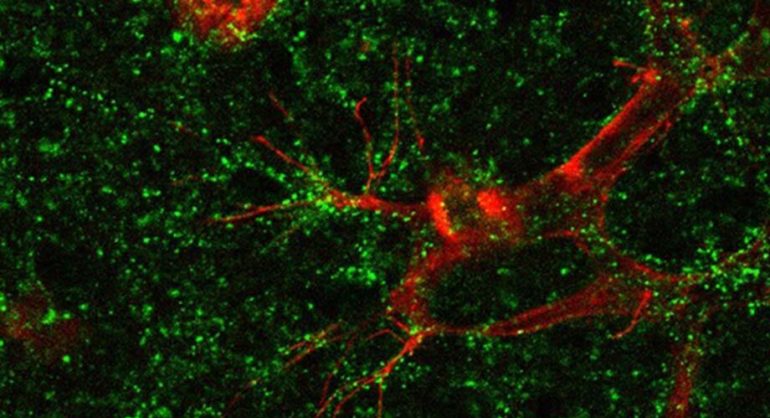Scientists at Scripps Research have uncovered a potential new strategy for treating eye diseases that affect millions of people around the world, often resulting in blindness.
Many serious eye diseases—including age-related macular degeneration, diabetic retinopathy and related disorders of the retina—feature abnormal overgrowth of new retinal blood vessel branches, which can lead to progressive loss of vision. It’s a phenomenon called “neovascularization.”
For the past decade and a half, eye doctors have been treating these conditions with drugs that block a protein, VEGF, that’s responsible for spurring new vessel growth. Such drugs have improved the treatment of these conditions, but don’t always work well and have potential safety issues. The Scripps Research scientists, in a study published in the Proceedings of the National Academy of Sciences, showed that a new approach that doesn’t target VEGF directly is highly effective in mice and has broader benefits than a standard VEGF-blocking treatment.
“We were thrilled to see how well this worked in the animal model,” says Rebecca Berlow, Ph.D., co-senior author of the study. “There really is a need for another way to treat patients who do not respond well to anti-VEGF treatments.”
Berlow is a staff scientist in the laboratory of Peter Wright, Ph.D., professor and Cecil H. and Ida M. Green Investigator in the Department of Integrative Structural and Computational Biology. The co-senior author on the study was Martin Friedlander, MD, Ph.D., professor in the Department of Molecular Medicine at Scripps Research, retina specialist and ophthalmologist in the Division of Ophthalmology at Scripps Clinic and President of the Lowy Medical Research Institute.
Ayumi Usui-Ouchi, MD, Ph.D., a post-doctoral fellow in Friedlander’s laboratory and visiting assistant professor from the Department of Ophthalmology at Juntendo University in Tokyo, Japan, led the laboratory effort.
“Our findings have important implications for treating these retinal diseases,” Friedlander says.
New alternative to an imperfect solution
Vision-impairing neovascularization in the retina typically represents the body’s faulty attempt to restore a blood supply that has been impaired by aging, diabetes, high blood cholesterol or other factors.
As the small vessels supplying the retina narrow or fail, oxygen levels in the retina decline. This low-oxygen condition, called hypoxia, is sensed by a protein called HIF-1α, which then triggers a complex “hypoxic response.” This response includes boosting production of the VEGF protein to bring more blood to areas in need. In principle, this is an adaptive, beneficial response. But chronic hypoxia leads to chronic and harmful—blindness-causing—overgrowth of abnormal, often leaky, new vessels.
Although anti-VEGF drugs stabilize or improve vision quality in most patients, about 40 percent are not significantly helped by these drugs. Moreover, researchers are concerned that the long-term blocking of VEGF, a growth factor needed for the health of many tissues including the retina, may do harm along with good. Many cases of retinal neovascularization are accompanied by the loss of tiny blood vessels elsewhere in the retina, and blocking VEGF inhibits or prevents the re-growth of these vessels.
In a 2017 paper in Nature, Berlow and colleagues described the workings of a different protein that naturally dials down the hypoxic response and thus might be the basis for an alternative treatment strategy. The protein, CITED2, is produced by HIF-1α as part of the hypoxic response, and apparently functions as a “negative feedback” regulator that blocks HIF-1α’s ability to switch on hypoxic response genes—keeping the response from becoming too strong or staying on too long.
A winning combination
For the new study, the team of researchers conducted tests in a mouse model of retinal hypoxia and neovascularization, using a fragment of CITED2 that contains its functional, hypoxic-response-blocking elements.
They showed that when a solution of the CITED2 fragment was injected into the eye, it lowered the activity of genes that are normally switched on by HIF-1α in retinal cells, and significantly reduced neovascularization. Moreover, it did so while preserving, or allowing to re-grow, the healthy capillaries in the retina that would otherwise have been destroyed—researchers call it “vaso-obliteration”—in this model of retinal disease.
In the same mouse model, the researchers tested a drug called aflibercept, a standard anti-VEGF treatment. It helped reduce neovascularization, but did not prevent the destruction of retinal capillaries. However, reducing the dose of aflibercept and combining it with the CITED2 fragment yielded better results than either alone, strongly reducing neovascularization while preserving and restoring retinal capillaries.
CITED2’s ability to combine these two benefits appears to represent a key advance, the researchers conclude.
“Most hypoxia-related retinal disorders, such as diabetic retinopathy, have extensive capillary loss in late stages of disease, leading to neuronal cell death and vision loss,” Friedlander says. “No current treatment has any therapeutic benefit for this aspect of the disorder.”
The researchers now hope to develop the CITED2-based treatment further, with the ultimate goal of testing it in human clinical trials.
“An allosteric peptide inhibitor of HIF-1α regulates hypoxia-induced retinal neovascularization” was authored by Ayumi Usui-Ouchi, Edith Aguilar, Salome Murinello, Peter Wright, Rebecca Berlow, and Martin Friedlander, of Scripps Research; and by Mitchell Prins and Marin Gantner of the Lowy Medical Research Institute.
Researchers identify new target for abnormal blood vessel growth in the eyes
More information:
Ayumi Usui-Ouchi et al, An allosteric peptide inhibitor of HIF-1α regulates hypoxia-induced retinal neovascularization, Proceedings of the National Academy of Sciences (2020). DOI: 10.1073/pnas.2017234117
Provided by
The Scripps Research Institute
Citation:
New strategy for treating common retinal diseases shows promise (2020, October 27)
retrieved 27 October 2020
from https://medicalxpress.com/news/2020-10-strategy-common-retinal-diseases.html
This document is subject to copyright. Apart from any fair dealing for the purpose of private study or research, no
part may be reproduced without the written permission. The content is provided for information purposes only.



